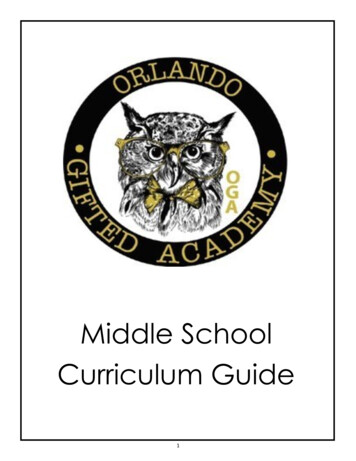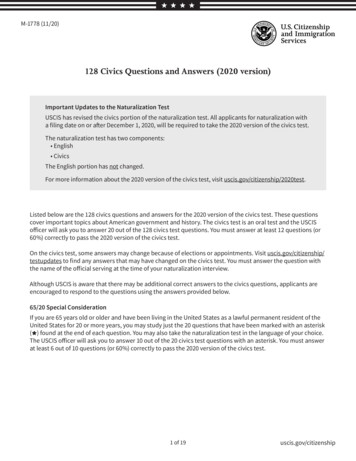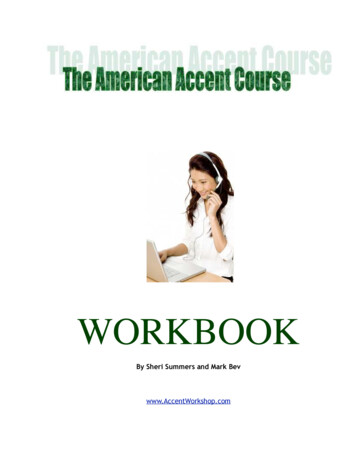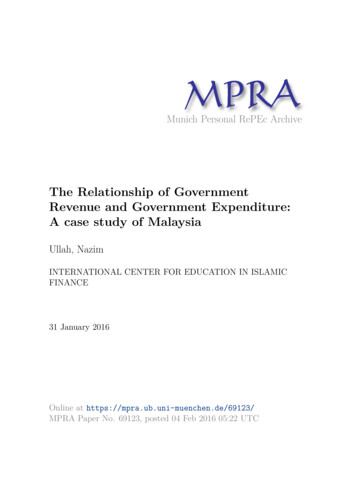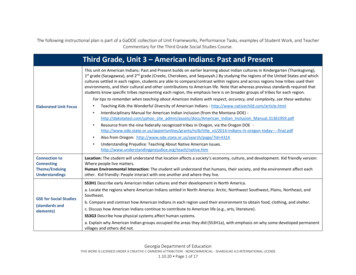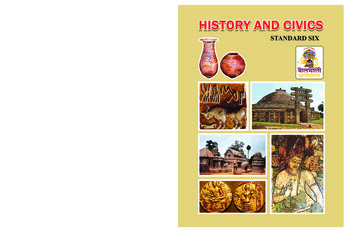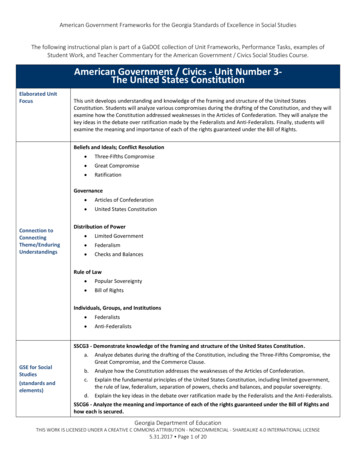
Transcription
American Government Frameworks for the Georgia Standards of Excellence in Social StudiesThe following instructional plan is part of a GaDOE collection of Unit Frameworks, Performance Tasks, examples ofStudent Work, and Teacher Commentary for the American Government / Civics Social Studies Course.American Government / Civics - Unit Number 3The United States ConstitutionElaborated UnitFocusThis unit develops understanding and knowledge of the framing and structure of the United StatesConstitution. Students will analyze various compromises during the drafting of the Constitution, and they willexamine how the Constitution addressed weaknesses in the Articles of Confederation. They will analyze thekey ideas in the debate over ratification made by the Federalists and Anti-Federalists. Finally, students willexamine the meaning and importance of each of the rights guaranteed under the Bill of Rights.Beliefs and Ideals; Conflict Resolution Three-Fifths Compromise Great Compromise RatificationGovernanceConnection toConnectingTheme/EnduringUnderstandings Articles of Confederation United States ConstitutionDistribution of Power Limited Government Federalism Checks and BalancesRule of Law Popular Sovereignty Bill of RightsIndividuals, Groups, and Institutions Federalists Anti-FederalistsSSCG3 - Demonstrate knowledge of the framing and structure of the United States Constitution.GSE for SocialStudies(standards andelements)a.Analyze debates during the drafting of the Constitution, including the Three-Fifths Compromise, theGreat Compromise, and the Commerce Clause.b.Analyze how the Constitution addresses the weaknesses of the Articles of Confederation.c.Explain the fundamental principles of the United States Constitution, including limited government,the rule of law, federalism, separation of powers, checks and balances, and popular sovereignty.d.Explain the key ideas in the debate over ratification made by the Federalists and the Anti-Federalists.SSCG6 - Analyze the meaning and importance of each of the rights guaranteed under the Bill of Rights andhow each is secured.Georgia Department of EducationTHIS WORK IS LICENSED UNDER A CREATIVE C OMMONS ATTRIBUTION - NONCOMMERCIAL - SHAREALIKE 4.0 INTERNATIONAL LICENSE5.31.2017 Page 1 of 20
American Government Frameworks for the Georgia Standards of Excellence in Social StudiesL9-10RHSS1- Cite specific textual evidence to support analysis of primary and secondary sources, attending tosuch features as the date and origin of the information.Connection toLiteracy Standardsfor Social Studies(reading and/orwriting)L9-10RHSS3 - Analyze in detail a series of events described in a text; determine whether earlier events causedlater ones or simply preceded them.L9-10RHSS6- Compare the point of view of two or more authors for how they treat the same or similar topics,including which details they include and emphasize in their respective accounts.L9-10WHST1- Write arguments focused on discipline-specific content.Information Processing Skills:4. Distinguish between fact and opinion5. Identify main idea, detail, sequence of events, and cause and effect in a social studies context6. Identify and use primary and secondary sourcesConnection toSocial StudiesMatrices(informationprocessing and/ormap and globeskills)8. Identify social studies reference resources to use for a specific purpose10. Analyze artifacts11. Draw conclusions and make generalizations17. Interpret political cartoons.Map and Globe Skills:4. Compare and contrast categories of natural, cultural, and political features found on maps11. Compare maps with data sets (charts, tables, graphs) and/or readings to draw conclusions and makegeneralizations12. Use geographic technology and software to determine changes, identify trends, and generalize abouthuman activities.Georgia Department of EducationTHIS WORK IS LICENSED UNDER A CREATIVE C OMMONS ATTRIBUTION - NONCOMMERCIAL - SHAREALIKE 4.0 INTERNATIONAL LICENSE5.31.2017 Page 2 of 20
American Government Frameworks for the Georgia Standards of Excellence in Social StudiesEssential Questions and Related Supporting/Guiding QuestionsEnduringUnderstanding 1(Beliefs and Ideals;Conflict Resolution)EnduringUnderstanding 2(Governance)EnduringUnderstanding 3(Distribution ofPower)EnduringUnderstanding 4(Rule of Law)EnduringUnderstanding 5(Individuals,Groups, andInstitutions)How did the beliefs and ideals of the United States influence conflict resolutions at the ConstitutionalConvention? How are various American beliefs and ideals reflected in the Three-Fifths Compromise? How are various American beliefs and ideals reflected in the Great Compromise? How do Federalists and Anti-Federalists both influence ratification of the new US Constitution?How did the increasing complexity of the new American society develop a need for a more complex form ofgovernment at the federal level? How was the United States challenged by the government structure of the Articles of Confederation? How did the new United States Constitution address the needs of the growing nation?How does the United States Constitution distribute power in the government in a way that reflects the valuesand beliefs of American society? Why is limited government a fundamental principle of the American government? Why is federalism a fundamental principle of the American government? Why are checks and balances fundamental in the American form of government?How does the Rule of Law influence the behavior of citizens and establish procedures for making policies in theAmerican democracy? Why is popular sovereignty a fundamental principle that guides the Rule of Law in the United States? How does the Bill of Rights help guide the Rule of Law in the United States?How did the actions of individuals and groups influence the United States Constitution ratification process? How did the Federalists influence the debate over ratification? How did the Anti-Federalists influence the debate over ratification?Georgia Department of EducationTHIS WORK IS LICENSED UNDER A CREATIVE C OMMONS ATTRIBUTION - NONCOMMERCIAL - SHAREALIKE 4.0 INTERNATIONAL LICENSE5.31.2017 Page 3 of 20
American Government Frameworks for the Georgia Standards of Excellence in Social StudiesSample Instructional Activities/AssessmentsConcepts in American Government: Three-Fifths CompromiseActivity: Using the following website, /essays/6/three-fifths-clause,students will read through the Three-Fifths Compromise, found in the Constitution under Article 1, Section 2, Clause 3.Another resource follows: titution/three-fifths-compromise.htm.This resource outlines the impact of the Three-Fifths Compromise.After the students have researched primary documents and gained a basic understanding of the Three-FifthsCompromise, they will reflect on the perspectives, from both sides – the government and the slaves – and they willwrite a journal entry based on that reflection. It should be two to three paragraphs in length.GSE Standards andElementsLiteracy StandardsSSCG3 - Demonstrate knowledge of the framing and structure of the United States Constitutiona.Analyze debates during the drafting of the Constitution, including the Three-Fifths Compromise, the GreatCompromise, and the Commerce Clause.L9-10RHSS1 –Cite specific textual evidence to support analysis of primary and secondary sources, attending to such features as thedate and origin of information.L9-10RHSS3 –Analyze in detail a series of events described in a text; determine whether earlier events caused later ones or simplypreceded them.L9-10RHSS10 –By the end of grade 10, read and comprehend history/social studies texts in the grades 9-10 complexity bandindependently and proficiently.L9-10WHST1 –Write arguments focused on discipline-specific content.Social StudiesMatricesMAP SKILLS:4. Compare and contrast the categories of natural, cultural, and political features found on maps11. Compare maps with data sets (charts, tables, graphs), and/or readings to draw conclusions and makegeneralizations17. Use geographic technology and software to determine changes, identify trends, and generalize about humanactivities.INFORMATION PROCESSING SKILLS:4. Distinguish between fact and opinion5. Identify main idea, detail, and sequence of events, and cause and effect in a social studies context6. Identify and use primary and secondary sources8. Identify social studies reference resources to use for a specific purpose10. Analyze artifacts11. Draw conclusions and make generalizations17. Interpret political cartoons.EnduringUnderstanding(s)Beliefs and Ideals; Conflict ResolutionGeorgia Department of EducationTHIS WORK IS LICENSED UNDER A CREATIVE C OMMONS ATTRIBUTION - NONCOMMERCIAL - SHAREALIKE 4.0 INTERNATIONAL LICENSE5.31.2017 Page 4 of 20
American Government Frameworks for the Georgia Standards of Excellence in Social StudiesSample Instructional Activities/AssessmentsConcepts in American Government: The Great CompromiseUsing primary resources, students will analyze the significance of the Great Compromise to the structure of the legislative branch.Activity: Students will use online tools to research primary documents for The Great Compromise. They will use thegraphic organizer below to illustrate how points from both the Virginia Plan and the New Jersey Plan came together toform the Connecticut Compromise, better known as The Great Compromise.Activity #2: Students will create a political cartoon, as it relates to the Great Compromise. Included in the cartoonshould be the challenges of coming to an agreement from the contending viewpoints of those who supported theVirginia Plan and those who supported the New Jersey Plan.GSE Standards andElementsLiteracy StandardsSSCG3 - Demonstrate knowledge of the framing and structure of the United States Constitutiona.Analyze debates during the drafting of the Constitution, including the Three-Fifths Compromise, the GreatCompromise, and the Commerce Clause.L9-10RHSS1 –Cite specific textual evidence to support analysis of primary and secondary sources, attending to such features as thedate and origin of information.L9-10RHSS3 –Analyze in detail a series of events described in a text; determine whether earlier events caused later ones or simplypreceded them.L9-10RHSS10 –By the end of grade 10, read and comprehend history/social studies texts in the grades 9-10 complexity bandindependently and proficiently.L9-10WHST1 – Write arguments focused on discipline-specific content.Social StudiesMatricesMAP SKILLS:4. Compare and contrast the categories of natural, cultural, and political features found on maps11. Compare maps with data sets (charts, tables, graphs), and/or readings to draw conclusions and makegeneralizations17. Use geographic technology and software to determine changes, identify trends, and generalize about humanactivities.INFORMATION PROCESSING SKILLS:4. Distinguish between fact and opinion5. Identify main idea, detail, and sequence of events, and cause and effect in a social studies context6. Identify and use primary and secondary sources8. Identify social studies reference resources to use for a specific purpose10. Analyze artifacts11. Draw conclusions and make generalizations17. Interpret political cartoons.EnduringUnderstanding(s)Beliefs and Ideals; Conflict ResolutionGeorgia Department of EducationTHIS WORK IS LICENSED UNDER A CREATIVE C OMMONS ATTRIBUTION - NONCOMMERCIAL - SHAREALIKE 4.0 INTERNATIONAL LICENSE5.31.2017 Page 5 of 20
American Government Frameworks for the Georgia Standards of Excellence in Social 74946/Georgia Department of EducationTHIS WORK IS LICENSED UNDER A CREATIVE C OMMONS ATTRIBUTION - NONCOMMERCIAL - SHAREALIKE 4.0 INTERNATIONAL LICENSE5.31.2017 Page 6 of 20
American Government Frameworks for the Georgia Standards of Excellence in Social StudiesSample Instructional Activities/AssessmentsConcepts in American Government: Commerce ClauseUsing primary resources, students will investigate the significance of the Commerce Clause.Activity: Students will use the link to the following website to research the terms of the United States Constitution's CommerceClause. They will take notes on the guidelines included in the lauseThen, students will be divided into three groups to study a landmark Supreme Court case that defined the role of the nationalgovernment in commerce. The case is Gibbons v. Ogden. All of the facts and circumstances of the case can be found e were 7 Supreme Court justices during the era of this case, so 7 students will play the role of justices. They will elect oneindividual to serve as the Chief Justice. The remaining students will be divided into two groups. One side will play the role ofGibbons, the plaintiff, while the other side will play the role of the defendant, Ogden. Both the plaintiff and defendant groupswill prepare their cases. This may take one to two class periods. Once both sides are ready to argue their case, they will taketurns in front of the Supreme Court. Each side will have a maximum of 10 minutes to argue their case. After the arguments havebeen presented, the Supreme Court justices will meet in private to make a decision on the case. They will prepare a briefmajority opinion and dissenting opinion, if the vote is not unanimous.GSE Standards andElementsLiteracy StandardsSSCG3 - Demonstrate knowledge of the framing and structure of the United States Constitutiona.Analyze debates during the drafting of the Constitution, including the Three-Fifths Compromise, the GreatCompromise, and the Commerce Clause.L9-10RHSS1 – Cite specific textual evidence to support analysis of primary and secondary sources, attending to suchfeatures as the date and origin of information.L9-10RHSS3 – Analyze in detail a series of events described in a text; determine whether earlier events caused laterones or simply preceded them.L9-10RHSS10 – By the end of grade 10, read and comprehend history/social studies texts in the grades 9-10complexity band independently and proficiently.L9-10WHST1 – Write arguments focused on discipline-specific content.MAP SKILLS:4. Compare and contrast the categories of natural, cultural, and political features found on mapsSocial StudiesMatrices11. Compare maps with data sets (charts, tables, graphs), and/or readings to draw conclusions and makegeneralizations17. Use geographic technology and software to determine changes, identify trends, and generalize about humanactivities.INFORMATION PROCESSING SKILLS:4. Distinguish between fact and opinion5. Identify main idea, detail, and sequence of events, and cause and effect in a social studies context6. Identify and use primary and secondary sources8. Identify social studies reference resources to use for a specific purpose11. Draw conclusions and make eorgia Department of EducationTHIS WORK IS LICENSED UNDER A CREATIVE C OMMONS ATTRIBUTION - NONCOMMERCIAL - SHAREALIKE 4.0 INTERNATIONAL LICENSE5.31.2017 Page 7 of 20
American Government Frameworks for the Georgia Standards of Excellence in Social StudiesSample Instructional Activities/AssessmentsConcepts in American Government: Articles of ConfederationUsing primary resources, online research, and a graphic organizer, students will understand the content and weaknesses of theArticles of Confederation.ACTIVITY #1: The Articles of Confederation primary document can be downloaded from the Library of Congress /articles.htmlBelow is a ‘student-friendly” version of the Articles of Confederation:ACTIVITY #2: Using a graphic organizer similar to the one below, have students explore and identify the powers given to thestate and national governments by the Articles, along with a listing of the weaknesses of the Articles of Confederation.GSE Standards andElementsLiteracy StandardsSSCG3 - Demonstrate knowledge of the framing and structure of the United States Constitutionb. Analyze how the Constitution addresses the weaknesses of the Articles of Confederation.L9-10RHSS1 –Cite specific textual evidence to support analysis of primary and secondary sources, attending to such features as thedate and origin of information.L9-10RHSS3 –Analyze in detail a series of events described in a text; determine whether earlier events caused later ones or simplypreceded them.L9-10RHSS10 –By the end of grade 10, read and comprehend history/social studies texts in the grades 9-10 complexity bandindependently and proficiently.L9-10WHST1 – Write arguments focused on discipline-specific content.Social StudiesMatricesMAP SKILLS:4. Compare and contrast the categories of natural, cultural, and political features found on maps11. Compare maps with data sets (charts, tables, graphs), and/or readings to draw conclusions and makegeneralizations17. Use geographic technology and software to determine changes, identify trends, and generalize about humanactivities.INFORMATION PROCESSING SKILLS:4. Distinguish between fact and opinion5. Identify main idea, detail, and sequence of events, and cause and effect in a social studies context6. Identify and use primary and secondary sources8. Identify social studies reference resources to use for a specific purpose10. Analyze artifacts11. Draw conclusions and make generalizations17. Interpret political cartoons.EnduringUnderstanding(s)GovernanceGeorgia Department of EducationTHIS WORK IS LICENSED UNDER A CREATIVE C OMMONS ATTRIBUTION - NONCOMMERCIAL - SHAREALIKE 4.0 INTERNATIONAL LICENSE5.31.2017 Page 8 of 20
American Government Frameworks for the Georgia Standards of Excellence in Social StudiesSTUDENT-FRIENDLY VERSION OF THE ARTICLES OF CONFEDERATIONPreambleTo everyone who reads this document, we the undersigned delegates send greetings.Articles of Confederation and permanent union among the states of New Hampshire, Massachusetts, RhodeIsland, Connecticut, New York, New Jersey, Pennsylvania, Delaware, Maryland, Virginia, North Carolina,South Carolina, and Georgia.Article I: The new nation will be called “The United States of America”.Article II: All states are independent from one another. The state governments will retain all powers that arenot specifically given to the national Congress.Article III: The states agree to maintain friendly relationships. They will defend one another in times of troubleand protect their shared liberties and mutual welfare.Article IV: To maintain friendly relations among the states, all free inhabitants can move among the states andconduct business wherein without extra taxes. If fugitives from one state are living in another state, they shouldbe sent back to face prosecution. All records and judicial rulings applying to individuals in one state should beaccepted by all other states.Article V: Every year, state legislatures will send representatives to the national Congress. Each state shall sendno less than two and no more than seven delegates, and each state will have only one vote in Congress.Article VI: No state can enter into a formal alliance with any foreign power. Neither states no Congress shallgive any title of nobility to anyone in the United States. Two or more states cannot enter into their own treaty.States cannot maintain standing armies or navies without Congress’ approval. Unless invaded, no state shallwage war without permission from Congress.Article VII: In times of war, state legislatures will appoint all officers under the rank of colonel and maintaintheir armies.Article VIII: To pay for war, states will receive money from the National Treasury in proportion to the amountof land they own. The state legislatures will collect the taxes needed to fund the Treasury.Article IX: The national Congress will have the power to: Declare warNegotiate foreign treatiesSettle disputes between statesRegulate currencyDirect the operations of land and naval forcesBorrow money from the statesGeorgia Department of EducationTHIS WORK IS LICENSED UNDER A CREATIVE C OMMONS ATTRIBUTION - NONCOMMERCIAL - SHAREALIKE 4.0 INTERNATIONAL LICENSE5.31.2017 Page 9 of 20
American Government Frameworks for the Georgia Standards of Excellence in Social StudiesCongress cannot carry out any resolution unless nine of the thirteen states agree.Congress will have a president to organize debate for a one-year term.Article X: A committee of the states will be given the power to run the United States during the times Congressis in recess.Article XI: Canada will be allowed admission into the United States. Any other colony requesting admissionwill need nine votes in Congress.Article XII: Congress pledges to repay any money borrowed from individual states during the Revolution.Article XIII: All states agree to abide by the Articles of Confederation. To amend the Articles, Congress andall of the state legislatures must unanimously agree.After students read through the Articles of Confederation, they should complete the following graphic organizerfound in Activity #2:Georgia Department of EducationTHIS WORK IS LICENSED UNDER A CREATIVE C OMMONS ATTRIBUTION - NONCOMMERCIAL - SHAREALIKE 4.0 INTERNATIONAL LICENSE5.31.2017 Page 10 of 20
American Government Frameworks for the Georgia Standards of Excellence in Social StudiesARTICLES OF CONFEDERATION GRAPHIC ORGANIZERConfederation:State Government PowersNational Government Powers*Taxation*Create a state court system*Enforce laws passed byCongress*Limited powers*Declare and wage war*Make treaties*Settle disputes between states*Petition, or request,moneyfrom the states (but nopower to collect)*Direct operations of landand naval forces*All powers not delegated tothe national governmentWeaknesses of the Articles ofConfederation*National government cannot impose or collect taxes*No national currency*No national court system*No executive branch*No power to regulate trade among the states*One vote per state regardless of population*Two-thirds majority (9 of 13 states) needed to pass laws*Unanimous consent (13 states) needed to amend the Articlesof ConfederationGeorgia Department of EducationTHIS WORK IS LICENSED UNDER A CREATIVE C OMMONS ATTRIBUTION - NONCOMMERCIAL - SHAREALIKE 4.0 INTERNATIONAL LICENSE5.31.2017 Page 11 of 20
American Government Frameworks for the Georgia Standards of Excellence in Social StudiesSample Instructional Activities/AssessmentsConcepts in American Government: Limited GovernmentUsing online tools, students will develop an understanding of limited government by creating their own political cartoon.ACTIVITY: Students will create their own political cartoon depicting the concept of limited government. Studentsmay draw the cartoon, or they may create it online using graphic tools.SSCG3 - Demonstrate knowledge of the framing and structure of the United States ConstitutionGSE Standards andElementsc. Explain the fundamental principles of the United States Constitution, including limited government, the rule oflaw, federalism, separation of powers, checks and balances, and popular sovereignty.Literacy StandardsL9-10RHSS1 –Cite specific textual evidence to support analysis of primary and secondary sources, attending to such features as thedate and origin of information.L9-10RHSS3 –Analyze in detail a series of events described in a text; determine whether earlier events caused later ones or simplypreceded them.L9-10RHSS10 –By the end of grade 10, read and comprehend history/social studies texts in the grades 9-10 complexity bandindependently and proficiently.L9-10WHST1 – Write arguments focused on discipline-specific content.Social StudiesMatricesMAP SKILLS:4. Compare and contrast the categories of natural, cultural, and political features found on maps11. Compare maps with data sets (charts, tables, graphs), and/or readings to draw conclusions and makegeneralizations17. Use geographic technology and software to determine changes, identify trends, and generalize about humanactivities.INFORMATION PROCESSING SKILLS:4. Distinguish between fact and opinion5. Identify main idea, detail, and sequence of events, and cause and effect in a social studies context6. Identify and use primary and secondary sources8. Identify social studies reference resources to use for a specific purpose10. Analyze artifacts11. Draw conclusions and make generalizations17. Interpret political cartoons.EnduringUnderstanding(s)Distribution of PowerGeorgia Department of EducationTHIS WORK IS LICENSED UNDER A CREATIVE C OMMONS ATTRIBUTION - NONCOMMERCIAL - SHAREALIKE 4.0 INTERNATIONAL LICENSE5.31.2017 Page 12 of 20
American Government Frameworks for the Georgia Standards of Excellence in Social StudiesSample Instructional Activities/AssessmentsConcepts in American Government: FederalismUsing online tools, diagrams, and charts, students will examine the political concept of federalism.ACTIVITY #1: Under federalism, there are some powers that are specifically given to the national government, and some powersthat are given to the state governments. Other powers are shared by the national and state governments. Using a Venn Diagram,students will develop an understanding of which powers are assigned to each level of government, and which powers areshared. This activity can be completed on a white board. Students will take turns coming up to write in national, state, andshared powers. The diagram below provides a teacher guide for the answers.SSCG3 - Demonstrate knowledge of the framing and structure of the United States ConstitutionGSE Standards andElementsc. Explain the fundamental principles of the United States Constitution, including limited government, the rule oflaw, federalism, separation of powers, checks and balances, and popular sovereignty.Literacy StandardsL9-10RHSS1 –Cite specific textual evidence to support analysis of primary and secondary sources, attending to such features as thedate and origin of information.L9-10RHSS3 –Analyze in detail a series of events described in a text; determine whether earlier events caused later ones or simplypreceded them.L9-10RHSS10 –By the end of grade 10, read and comprehend history/social studies texts in the grades 9-10 complexity bandindependently and proficiently.L9-10WHST1 – Write arguments focused on discipline-specific content.Social StudiesMatricesMAP SKILLS:4. Compare and contrast the categories of natural, cultural, and political features found on maps11. Compare maps with data sets (charts, tables, graphs), and/or readings to draw conclusions and makegeneralizations17. Use geographic technology and software to determine changes, identify trends, and generalize about humanactivities.INFORMATION PROCESSING SKILLS:4. Distinguish between fact and opinion5. Identify main idea, detail, and sequence of events, and cause and effect in a social studies context6. Identify and use primary and secondary sources8. Identify social studies reference resources to use for a specific purpose10. Analyze artifacts11. Draw conclusions and make generalizations17. Interpret political cartoons.EnduringUnderstanding(s)Distribution of PowerGeorgia Department of EducationTHIS WORK IS LICENSED UNDER A CREATIVE C OMMONS ATTRIBUTION - NONCOMMERCIAL - SHAREALIKE 4.0 INTERNATIONAL LICENSE5.31.2017 Page 13 of 20
American Government Frameworks for the Georgia Standards of Excellence in Social StudiesGeorgia Department of EducationTHIS WORK IS LICENSED UNDER A CREATIVE C OMMONS ATTRIBUTION - NONCOMMERCIAL - SHAREALIKE 4.0 INTERNATIONAL LICENSE5.31.2017 Page 14 of 20
American Government Frameworks for the Georgia Standards of Excellence in Social StudiesSample Instructional Activities/AssessmentsConcepts in American Government: Popular SovereigntyUsing primary source documents, students will analyze the meaning of popular sovereignty and how it works.Activity: In this activity, students will analyze the concept of popular sovereignty through United States historicaldocuments. First, they will examine two primary source excerpts. As students read each one, ask them to think abouthow the source might relate to the concept of popular sovereignty. Then, students will write a definition of popularsovereignty in their own words. Using the graphic organizer below the excerpts, students will respond to a prompt.SSCG3 - Demonstrate knowledge of the framing and structure of the United States ConstitutionGSE Standards andElementsc. Explain the fundamental principles of the United States Constitution, including limited government, the rule oflaw, federalism, separation of powers, checks and balances, and popular sovereignty.Literacy StandardsL9-10RHSS1 –Cite specific textual evidence to support analysis of primary and secondary sources, attending to such features as thedate and origin of information.L9-10RHSS3 –Analyze in detail a series of events described in a text; determine whether earlier events caused later ones or simplypreceded them.L9-10RHSS10 –By the end of grade 10, read and comprehend history/social studies texts in the grades 9-10 complexity bandindependently and proficiently.L9-10WHST1 – Write arguments focused on discipline-specific content.Social StudiesMatricesMAP SKILLS:4. Compare and contrast the categories of natural, cultural, and political features found on maps11. Compare maps with data sets (charts, tables, graphs), and/or readings to draw conclusions and makegeneralizations17. Use geographic technology and software to determine changes, identify trends, and generalize about humanactivities.INFORMATION PROCESSING SKILLS:4. Distinguish between fact and opinion5. Identify main idea, detail, and sequence of events, and cause and effect in a social studies context6. Identify and use primary and secondary sources8. Identify social studies reference resources to use for a specific purp
American Government Frameworks for the Georgia Standards of Excellence in Social Studies . graphic organizer below to illustrate how points from both the Virginia Plan and the New Jersey Plan came toget
